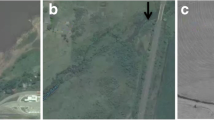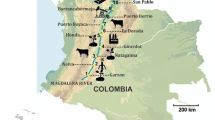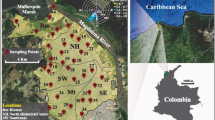Abstract
Heavy metal pollution is a global environmental problem, and the potential risks associated with heavy metals are increasing. The acid mine drainage (AMD) which is generated by mining activities at Dabaoshan Mine, the largest polymetallic mine in southern China, is harmful to local residents. A detailed regional survey of the ecological and human health risks of this polluted area is urgently needed. In this study, eight sediments and farmland samples were collected along the flow direction of tailing wastewater and Fandong Reservoir; the content of multiple heavy metals in these samples was determined by inductively coupled plasma mass spectrometry. The biological toxicity of water-soluble extracts from the samples was further assessed by referring to different endpoints of Caenorhabditis elegans (C. elegans). The relationship between specific heavy metals and biological toxicity was estimated by partial least squares regression. The results indicated that the risk of heavy metals in Dabaoshan mining area was very high (potential ecological risk index = 721.53) and was related to geographical location. In these samples, the carcinogenic risk (the probability that people are induced carcinogenic diseases or injuries when exposed to carcinogenic pollutants) of arsenic (As) for adults exceeded the standard value 1 × 10−4 and indicated that As presented a high carcinogenic risk to adults, while the high risk of non-carcinogenic effects (the hazard degree of human exposure to non-carcinogenic pollutants) in children was related to lead exposure (hazard index = 1.24). In addition, the heavy metals at high concentration in the water-soluble fraction of sediment and farmland soil extracts, which might easily distribute within the water cycle, inhibited the survival rate and growth of C. elegans. Gene expression and enzymatic activity related to oxidative stress were increased and genes related to apoptosis and metallothionein were also affected. In conclusion, the results of chemical analysis and biological assays provided evidence on the toxicity of soil and sediment extracts in the Dabaoshan mining area and advocated the control and remediation of heavy metal pollution around Dabaoshan Mine.






Similar content being viewed by others
Data availability
The datasets generated and analyzed during the current study are not publicly available but are available from the corresponding author on reasonable request (Ling Wang: wangling4212@aliyun.com).
References
Adewumi AJ, Laniyan TA (2020) Contamination, sources and risk assessments of metals in media from Anka artisanal gold mining area, Northwest Nigeria. Sci Total Environ 718:137235. https://doi.org/10.1016/j.scitotenv.2020.137235
Akcil A, Koldas S (2006) Acid Mine Drainage (AMD): causes, treatment and case studies. J Clean Prod 14:1139–1145. https://doi.org/10.1016/j.jclepro.2004.09.006
Ali SH, Giurco D, Arndt N, Nickless E, Brown G, Demetriades A, Durrheim R, Enriquez MA, Kinnaird J, Littleboy A (2017) Mineral supply for sustainable development requires resource governance. Nature 543(7645):367. https://doi.org/10.1038/nature21359
Bradford MM (1976) A rapid and sensitive method for the quantitation of microgram quantities of protein utilizing the principle of protein-dye binding. Anal Biochem 72:248–254. https://doi.org/10.1016/0003-2697(76)90527-3
Brenner S (1974) The genetics of Caenorhabditis elegans. Genetics 77:71–94
Chapman EEV, Dave G, Murimboh JD (2013) A review of metal (Pb and Zn) sensitive and pH tolerant bioassay organisms for risk screening of metal-contaminated acidic soils. Environ Pollut 179:326–342. https://doi.org/10.1016/j.envpol.2013.04.027
Chen A, Lin C, Lu W, Wu Y, Ma Y, Li J, Zhu L (2007) Well water contaminated by acidic mine water from the Dabaoshan Mine, South China: chemistry and toxicity. Chemosphere 70:248–255. https://doi.org/10.1016/j.chemosphere.2007.06.041
Chen FJ, Wei CY, Chen QY, Zhang J, Wang L, Zhou Z, Chen MJ, Liang Y (2018a) Internal concentrations of perfluorobutane sulfonate (PFBS) comparable to those of perfluorooctane sulfonate (PFOS) induce reproductive toxicity in Caenorhabditis elegans. Ecotoxicol Environ Saf 158:223–229. https://doi.org/10.1016/j.ecoenv.2018.04.032
Chen YX, Jiang XS, Wang Y, Zhuang DF (2018b) Spatial characteristics of heavy metal pollution and the potential ecological risk of a typical mining area: a case study in China. Process Saf Environ Prot 113:204–219. https://doi.org/10.1016/j.psep.2017.10.008
CNEMC (1990) Background values of elements in soils of China. China Environmental Science Press, Beijing
Craig AL, Moser SC, Bailly AP, Gartner A (2012) Methods for studying the DNA damage response in the Caenorhabdatis elegans germ line. In: Rothman JH, Singson A (eds) Methods in Cell Biology. 107. Academic Press, pp. 321–352.https://doi.org/10.1016/B978-0-12-394620-1.00011-4
Daraz U, Li Y, Sun Q, Zhang M, Ahmad I (2021) Inoculation of Bacillus spp. Modulate the soil bacterial communities and available nutrients in the rhizosphere of vetiver plant irrigated with acid mine drainage. Chemosphere 263:128345.https://doi.org/10.1016/j.chemosphere.2020.128345
Hagner M, Romantschuk M, Penttinen OP, Egfors A, Marchand C, Augustsson A (2018) Assessing toxicity of metal contaminated soil from glassworks sites with a battery of biotests. Sci Total Environ 613–614:30–38.https://doi.org/10.1016/j.scitotenv.2017.08.121
Jaishankar M, Tseten T, Anbalagan N, Mathew BB, Beeregowda KN (2014) Toxicity, mechanism and health effects of some heavy metals. Interdiscip Toxicol 7:60–72. https://doi.org/10.2478/intox-2014-0009
Jiang Y, Chen J, Wu Y, Wang Q, Li H (2016) Sublethal toxicity endpoints of heavy metals to the nematode Caenorhabditis elegans. PLoS ONE 11:e0148014–e0148014. https://doi.org/10.1371/journal.pone.0148014
Jiang YX, Chao SH, Liu JW, Yang Y, Chen YJ, Zhang AC, Cao HB (2017) Source apportionment and health risk assessment of heavy metals in soil for a township in Jiangsu Province, China. Chemosphere 168:1658–1668. https://doi.org/10.1016/j.chemosphere.2016.11.088
Kamireddy K, Chinnu S, Priyanka PS, Rajini PS, Giridhar P (2018) Neuroprotective effect of Decalepis hamiltonii aqueous root extract and purified 2-hydroxy-4-methoxy benzaldehyde on 6-OHDA induced neurotoxicity in Caenorhabditis elegans. BiomedPharmacother 105:997–1005. https://doi.org/10.1016/j.biopha.2018.06.002
Khanna N, Cressman CP III, Tatara CP, Williams PL (1997) Tolerance of the nematode Caenorhabditis elegans to pH, salinity, and hardness in aquatic media. Arch Environ Contam Toxicol 32:110–114. https://doi.org/10.1007/s002449900162
Kumar R, Pradhan A, Khan FA, Lindström P, Ragnvaldsson D, Ivarsson P, Olsson PE, Jass J (2015) Comparative analysis of stress induced gene expression in Caenorhabditis elegans following exposure to environmental and lab reconstituted complex metal mixture. PLoS ONE 10:e0132896. https://doi.org/10.1371/journal.pone.0132896
Leung MCK, Williams PL, Benedetto A, Au C, Helmcke KJ, Aschner M, Meyer JN (2008) Caenorhabditis elegans: an emerging model in biomedical and environmental toxicology. Toxicol Sci 106:5–28. https://doi.org/10.1093/toxsci/kfn121
Li ZY, Ma ZW, van der Kuijp TJ, Yuan ZW, Huang L (2014) A review of soil heavy metal pollution from mines in China, Pollution and health risk assessment. Sci Total Environ 468–469:843–853. https://doi.org/10.1016/j.scitotenv.2013.08.090
Li SY, Zhang QF (2010) Risk assessment and seasonal variations of dissolved trace elements and heavy metals in the Upper Han River, China. J Hazard Mater 181:1051–1058. https://doi.org/10.1016/j.jhazmat.2010.05.120
Lin WT, Wu KM, Lao ZL, Hu W, Lin BJ, Li YL, Fan HB, Hu JJ (2019) Assessment of trace metal contamination and ecological risk in the forest ecosystem of dexing mining area in northeast Jiangxi Province, China. Ecotoxicol Environ Saf 167:76–82. https://doi.org/10.1016/j.ecoenv.2018.10.001
Liu Y, Lin C, Ma Y, Lu W, Wu Y, Huang S, Zhu L, Li J, Chen A (2009) Toxic effects of two acid sulfate soils from the Dabaoshan Mine on Corymbia citriodora var. variegata and Daphnia carinata. J Hazard Mater 166:1162–1168. https://doi.org/10.1016/j.jhazmat.2008.12.017
Man YB, Sun XL, Zhao YG, Lopez BN, Chung SS, Wu SC, Cheung KC, Wong MH (2010) Health risk assessment of abandoned agricultural soils based on heavy metal contents in Hong Kong, the world’s most populated city. Environ Int 36:570–576. https://doi.org/10.1016/j.envint.2010.04.014
Rai N, Sjöberg V, Forsberg G, Karlsson S, Olsson PE, Jass J (2019) Metal contaminated soil leachates from an art glass factory elicit stress response, alter fatty acid metabolism and reduce lifespan in Caenorhabditis elegans. Sci Total Environ 651:2218–2227. https://doi.org/10.1016/j.scitotenv.2018.10.067
Schultz E, Joutti A, Räisänen ML, Lintinen P, Martikainen E, Lehto O (2004) Extractability of metals and ecotoxicity of soils from two old wood impregnation sites in Finland. Sci Total Environ 326:1–84. https://doi.org/10.1016/j.scitotenv.2003.12.008
Shu XH, Zhang Q, Lu GN, Yi XY, Dang Z (2018) Pollution characteristics and assessment of sulfide tailings from the Dabaoshan Mine, China. Int Biodeterior Biodegrad 128:122–128. https://doi.org/10.1016/j.ibiod.2017.01.012
Song SJ, Zhang XY, Wu HH, Han Y, Zhang JZ, Ma EB, Guo YP (2014) Molecular basis for antioxidant enzymes in mediating copper detoxification in the nematode Caenorhabditis elegans. PLoS ONE 9(9):e107685. https://doi.org/10.1371/journal.pone.0107685
Tejeda-Benitez L, Flegal R, Odigie K, Olivero-Verbel J (2016) Pollution by metals and toxicity assessment using Caenorhabditis elegans in sediments from the Magdalena River, Colombia. Environ Pollut 212:238–250. https://doi.org/10.1016/j.envpol.2016.01.057
Tejeda-Benítez L, Noguera-Oviedo K, Aga DS, Olivero-Verbel J (2018) Toxicity profile of organic extracts from Magdalena River sediments. Environ Sci Pollut Res 25:1519–1532. https://doi.org/10.1007/s11356-017-0364-9
Tiwari S, Tambo F, Agarwal R (2020) Assessment of lead toxicity on locomotion and growth in a nematode Caenorhabditis elegans. J Appl Nat Sci 12:36–41. https://doi.org/10.31018/jans.v12i1.2227
Turner EA, Kroeger GL, Arnold MC, Thornton BL, Di Giulio RT, Meyer JN (2013) Assessing different mechanisms of toxicity in mountaintop removal/valley fill coal mining-affected watershed samples using Caenorhabditis elegans. PLoS ONE 8:e75329. https://doi.org/10.1371/journal.pone.0075329
USEPA (1989) Risk assessment guidance for superfund. Human Health evaluation manual, (part A) [R], vol. 1. Washington, DC: Office of emergency and remedial response. [EPA/540/1–89/002]
Vardhan KH, Kumar PS, Panda RC (2019) A review on heavy metal pollution, toxicity and remedial measures: current trends and future perspectives. J Mol Liq 290:111197. https://doi.org/10.1016/j.molliq.2019.111197
Wang Q, Liu BZ, Yang HS, Wang XY, Lin ZH (2009) Toxicity of lead, cadmium and mercury on embryogenesis, survival, growth and metamorphosis of Meretrix meretrix larvae. Ecotoxicology 18:829–837. https://doi.org/10.1007/s10646-009-0326-1
Wang XF, Miao JJ, Pan LQ, Li Y, Lin YF, Wu JY (2019a) Toxicity effects of p-choroaniline on the growth, photosynthesis, respiration capacity and antioxidant enzyme activities of a diatom, Phaeodactylum tricornutu. Ecotoxicol Environ Saf 169:654–661. https://doi.org/10.1016/j.ecoenv.2018.11.015
Wang Y, Dong R, Zhou YZ, Luo X (2019b) Characteristics of groundwater discharge to river and related heavy metal transportation in a mountain mining area of Dabaoshan, Southern China. Sci Total Environ 679:346–358. https://doi.org/10.1016/j.scitotenv.2019.04.273
Westerhuis JA, Hoefsloot HCJ, Smit S, Vis DJ, Smilde AK, van Velzen EJJ, van Duijnhoven JPM, van Dorsten FA (2008) Assessment of PLSDA cross validation. Metabolomics 4:81–89. https://doi.org/10.1007/s11306-007-0099-6
Xiang L, Liu PH, Jiang XF, Chen PJ (2019) Health risk assessment and spatial distribution characteristics of heavy metal pollution in rice samples from a surrounding hydrometallurgy plant area in No. 721 uranium mining, East China. J GeochemExplor 207:106360. https://doi.org/10.1016/j.gexplo.2019.106360
Xiao GS, Zhao L, Huang Q, Yang JN, Du HH, Guo DQ, Xia MX, Li GM, Chen ZX, Wang DY (2018) Toxicity evaluation of Wanzhou watershed of Yangtze Three Gorges Reservior in the flood season in Caenorhabditis elegans. Sci Rep 8:6734–6734. https://doi.org/10.1038/s41598-018-25048-w
Xu ZQ, Ni SJ, Tuo XG, Zhang CJ (2008) Calculation of heavy metal’s toxicity coefficient in the evaluation of Potential Ecological Risk Index. Environ Sci Technol 31:112–115 (In Chinese with English abstract)
Xu TT, Zhang MK, Hu JN, Li ZH, Wu TP, Bao JN, Wu SY, Lei LL, He DF (2017) Behavioral deficits and neural damage of Caenorhabditis elegans induced by three rare earth elements. Chemosphere 181:55–62. https://doi.org/10.1016/j.chemosphere.2017.04.068
Zeitoun-Ghandour S, Leszczyszyn O, Blindauer C, Geier F, Bundy J, Stürzenbaum S (2011) C. elegans metallothioneins: response to and defence against ROS toxicity. Mol BioSyst 7:2397–2406. https://doi.org/10.1039/c1mb05114h
Zeng FR, Qiu BY, Wu XJ, Niu SZ, Wu FB, Zhang GP (2012) Glutathione-mediated alleviation of chromium toxicity in rice plants. Biol Trace Elem Res 148:255–263. https://doi.org/10.1007/s12011-012-9362-4
Zhao HR, Xia BC, Fan C, Zhao P, Shen SL (2012) Human health risk from soil heavy metal contamination under different land uses near Dabaoshan Mine, Southern China. Sci Total Environ 417–418:45–54. https://doi.org/10.1016/j.scitotenv.2011.12.047
Zheng XZ, Wang RR, Wood R, Wang C, Hertwich EG (2018) High sensitivity of metal footprint to national GDP in part explained by capital formation. Nat Geosci 11:269–273. https://doi.org/10.1038/s41561-018-0091-y
Zhou JM, Dang Z, Cai MF, Liu CQ (2007) Soil heavy metal pollution around the Dabaoshan Mine, Guangdong Province, China. Pedosphere 17:588–594. https://doi.org/10.1016/S1002-0160(07)60069-1
Zhu DW, Wei Y, Zhao YH, Wang QL, Han JC (2018) Heavy metal pollution and ecological risk assessment of the agriculture soil in Xunyang Mining Area, Shaanxi Province, Northwestern China. Bull Environ Contam Toxicol 101:178–184. https://doi.org/10.1007/s00128-018-2374-9
Zhuang P, Lu H, Li Z, Zou B, McBride MB (2014) Multiple exposure and effects assessment of heavy metals in the population near mining area in South China. PLoS ONE 9:e94484. https://doi.org/10.1371/journal.pone.0094484
Funding
This study was financially supported by the National Natural Science Foundation of China (Grant number: 21906069 and 21777061) and the Open Fund of Hubei Key Laboratory of Environmental and Health Effects of Persistent Toxic Substance (PTS2020-3).
Author information
Authors and Affiliations
Contributions
Xin Li performed experiments and statistical analysis and wrote original draft. Qingqing Yang performed chemical analysis. Ling Wang designed experiments and revised the draft. Chuxin Song performed biological experiments. Lufeng Chen provided technical and editorial assistance. Jie Zhang conceived and designed the experiment. Yong Liang conceived the experiment. And all authors approved the final manuscript.
Corresponding authors
Ethics declarations
Ethics approval and consent to participate
Our research does not involve animal or human experiments, so ethics approval is not applicable.
Consent for publication
Our manuscript does not contain data from any individual person and its publication is approved by all authors. Therefore, the section “Consent for publication” is not applicable.
Competing interests
The authors declare no competing interests.
Additional information
Responsible Editor: Mohamed M. Abdel-Daim
Publisher's note
Springer Nature remains neutral with regard to jurisdictional claims in published maps and institutional affiliations.
Supplementary Information
Below is the link to the electronic supplementary material.
Rights and permissions
About this article
Cite this article
Li, X., Yang, Q., Wang, L. et al. Using Caenorhabditis elegans to assess the ecological health risks of heavy metals in soil and sediments around Dabaoshan Mine, China. Environ Sci Pollut Res 29, 16332–16345 (2022). https://doi.org/10.1007/s11356-021-16807-w
Received:
Accepted:
Published:
Issue Date:
DOI: https://doi.org/10.1007/s11356-021-16807-w




